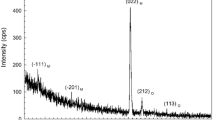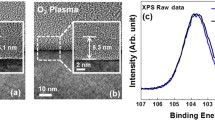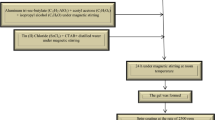Abstract
In this study, the forward bias current–voltage (I–V) and capacitance–voltage (C–V) characteristics of the Al/TiO2/p-Si (MIS) structures derived using the sol–gel method have been investigated and compared at various preparation temperatures. Experimental results show that the preparation temperatures strongly affect the electrical characteristics, such as ideality factor (n), zero-bias barrier height (\( \phi_{b0} \)), series resistance (R s ) and interface states (N ss ). The MIS structures show non-ideal behavior of I–V characteristics with an n varying between 2.17 and 4.61. We have found that the \( \phi_{b0} \) and R s increase as the n decrease with increasing preparation temperature. The energy distribution profile of N ss of the Al/TiO2/p-Si (MIS) structures was obtained from the forward bias I–V characteristics by taking into account both the bias dependence of the effective barrier height (\( \phi_{e} \)) and R s for various preparation temperatures. The values of N ss increase from the midgap towards the top of valance band for various preparation temperatures.






Similar content being viewed by others
References
Sze SM, Ng Kwok K (2007) Physics of semiconductor devices, 3nd edn. John Wiley, New Jersey
Rhoderick EH, Williams RH (1978) Metal-semiconductor contacts, 2nd edn. Clarendon Press, Oxford
Card HC, Rhoderick EH (1971) J Phys D 4:1589
Karataş Ş, Altındal Ş, Türüt A, Özmen A (2003) Appl Surf Sci 217:250. doi:10.1016/S0169-4332(03)00564-6
Zeyrek S, Altındal Ş, Yüzer H, Bülbül MM (2006) Appl Surf Sci 252:2999. doi:10.1016/j.apsusc.2005.05.008
Sullivan JP, Tung RT, Pinto MR, Graham WR (1991) J Appl Phys 70:7403. doi:10.1063/1.349737
Dökme İ, Altındal Ş (2006) Semicond Sci Technol 21:1053. doi:10.1088/0268-1242/21/8/012
Zhu S, Van Meirhaeghe RL, Detavernier C, Cardon F, Ru G, Qu X, Li B (2000) Solid-State Electron 44:663. doi:10.1016/S0038-1101(99)00268-3
Tekeli Z, Altındal Ş, Çakmak M, Ozçelik S, Ozbay E (2007) J Appl Phys 102:054510. doi:10.1063/1.2777881
Cheung SK, Cheung NW (1986) Appl Phys Lett 49:85. doi:10.1063/1.97359
Singh A, Reinhardt KC, Anderson WA (1990) J Appl Phys 68:3478
Hudait MK, Krupanidhi SB (2001) Mater Sci Eng B 87:141. doi:10.1016/S0921-5107(01)00713-9
Hudait MK, Venkateswarlu P, Krupanidhi SB (2001) Solid-State Electron 45:1332. doi:10.1016/S0038-1101(00)00230-6
Crowell CR, Sze SM (1965) J Appl Phys 36:3212. doi:10.1063/1.1713959
Chattopadhyay P, Raychaudhuri B (1993) Solid-State Electron 35:605. doi:10.1016/0038-1101(93)90272-R
Akkal B, Benemara Z, Boudissa A, Bouiadjra NB, Amrani M, Bideux L, Gruzza B (1998) Mater Sci Eng B 55:162. doi:10.1016/S0921-5107(98)00168-8
Çetinkara HA, Türüt A, Zengin DM, Erel Ş (2003) Appl Surf Sci 207:190. doi:10.1016/S0169-4332(02)01323-5
Dökme İ, Altındal Ş (2007) Physica B 393:328. doi:10.1016/j.physb.2007.01.020
Nicollian EH, Brews JR (1982) Metal-oxide semiconductor (mos) physics and technology. Wiley, New York
Tataroğlu A, Altındal Ş (2006) Microelectron Eng 83:582. doi:10.1016/j.mee.2005.12.014
Chakraborty S, Bera MK, Bose PK, Maiti CK (2006) Semicond Sci Technol 21:335. doi:10.1088/0268-1242/21/3/022
Yang L, Scott Saavedra S, Armstrong NR, Hayes J (1994) Anal Chem 66:1254. doi:10.1021/ac00080a010
Choi Y, Yamamoto S, Umebayashi T, Yoshikawa M (2004) Solid State Ion 172:105–108. doi:10.1016/j.ssi.2004.03.014
Czapla A, Kusior E, Bucko M (1989) Thin Solid Films 182:15. doi:10.1016/0040-6090(89)90239-3
Sanon G, Rup R, Mansingh A (1990) Thin Solid Films 190:287. doi:10.1016/0040-6090(89)90918-8
Ha HY, Nam SW, Lim TH, Oh IH, Hong SA (1996) J Membr Sci 111:81. doi:10.1016/0376-7388(95)00278-2
Alam MJ, Cameron DC (2002) Sol-Gel Sci J Tech 25:137
Wen T, Gao J, Shen J (2001) J Mater Sci 36:5923. doi:10.1023/A:1012989012840
Werner JH, Güttler HH (1991) J Appl Phys 69:1522. doi:10.1063/1.347243
Kern W (1993) Handbook of semiconductor cleaning technology. Noyes, New York
Clark RJH (1968) An introduction to the chemistry of the early transition elements. Elsevier, New York
Yang W, Marino J, Monson A, Wolden CA (2006) Semicond Sci Technol 21:1573. doi:10.1088/0268-1242/21/12/012
Acknowledgment
This work was supported by Ankara University (BIYEP) Project number 2005-K–120-140-8 and Ankara University Scientific Research Project (BAP), 2007-07-45-054.
Author information
Authors and Affiliations
Corresponding author
Rights and permissions
About this article
Cite this article
Pakma, O., Serin, N., Serin, T. et al. The effects of preparation temperature on the main electrical parameters of Al/TiO2/p-Si (MIS) structures by using sol–gel method. J Sol-Gel Sci Technol 50, 28–34 (2009). https://doi.org/10.1007/s10971-009-1895-4
Received:
Accepted:
Published:
Issue Date:
DOI: https://doi.org/10.1007/s10971-009-1895-4




